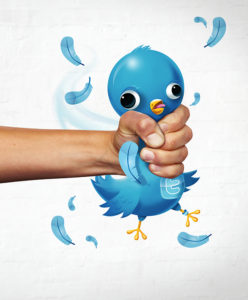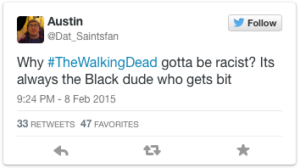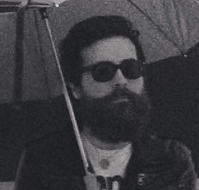As I hunkered down and prepared for the snowstorm that passed through Richmond last night, I decided to head over to a few of my favorite websites to save some articles for offline use in case I was to lose power. Fortunately my apartment complex managed to stay on the grid (though no one is able to drive anywhere because THE SNOW PLOWS HAVEN’T SHOWN UP), so I’ve had some time to revise the Digital America post I’d written for Tuesday’s update.
One of the articles I read, which Atlantic writer Derek Thompson titled “The Unbearable Lightness of Tweeting,” manages to sum up most of my opinions regarding social media, particularly Twitter, through a small experiment that reveals just how many readers a link can attract. Through a new feature called “View Tweet Activity,” users can see some basic stats that show how many clicks, views, shares, etc. they’ve had for particular posts. Thompson used this tool to track the impact that one of his posts for The Atlantic had on his supposed readers, and the results were striking: While his post garnered 155,260 “impressions,” only 2.9% of these users clicked the image in the Tweet, 1.1% retweeted or favored it, and only 1%, ONE PERCENT, clicked on the actual link that led to the Atlantic article that the Tweet was originally promoting.
Thompson then came to a harsh realization: “I had created something that 150,000 people had seen, 9,000 people had interacted with, and just 1,500 had followed to our site to actually read…99% of my labor on Twitter went to Twitter, and 1 percent went to The Atlantic. That’s not a very good deal for our boss!”

However, the fact of the matter is that the social media middlemen aren’t doing as much as people once thought. Sure, people may be seeing a link or a photo for, say, Shorpy (an awesome website featuring high-quality images dating back to the dawn of photography) as they scroll through their newsfeeds, but most of their interactions with this content stay on Facebook. You see a picture from Shorpy with an interesting caption and a link that leads to their website, you leave a Facebook comment like “wow, what a great photo,” and you keep on scrolling. This does nothing for Shorpy in the long run, because less visits to their website leads to less ad-generated revenue.
This got me onto a bit of an anti-social media kick as I watched the snow start to pile up outside my apartment’s window. Full disclosure, I’m still pretty “connected” through Instagram, Reddit, Snapchat and Facebook via my own online identities, but I feel that it’s still good practice to examine your hobbies and habits every once in a while. Who knows, it could be the first step in a recovery plan I don’t even think is necessary yet.
Anyways, I started thinking about the “influence” that “social media celebrities” have had on our culture in the past few years and, even worse, the stock that journalists put into public reactions that are posted online. A few of the articles I saved last night concerned AMC’s The Walking Dead and some diversity-related “drama” (I can’t remember the last time I used so many sarcastic quotation marks in a post, but they’re relevant here). Apparently, some Twitter users decided to point out that the show killed off a black character during Black History Month for whatever reason. Here are some headlines:
‘The Walking Dead’ Under Fire For Killing Off A Black Character During Black History Month
Is ‘The Walking Dead’ too diverse?
Liberal fans cry ‘racist’ after show kills off major character (Link is no longer available)
‘The Walking Dead’ Under Fire As Twitter Erupts With Accusations Of Racism (Link is no longer available)
Racist Race Hustlers Go After AMC’s ‘The Walking Dead’
I could easily lose my voice if you asked me to make a list of things more newsworthy than this non-story. Regardless, The Walking Dead’s executive producer had to actually address this “issue” in a recent interview: “‘Look, this is something in this world that we should be cognizant about, so my feeling is: Sure, let’s get it out there, let’s talk about…We’ve killed a lot more white characters than African-American characters.’”

The funny thing is that there were probably a dozen or so fans of the show who decided to Tweet about this “racist” act, which most likely resulted in a hashtag that began to trend, which then led to thousands of other Twitter users piggybacking onto what can only be described as a joke. In the end, the show was set on fire due to the lava that flowed from erupting Mount Twitter (to paraphrase my favorite headline, shown above).
It’s as if Twitter is being monitored by a Richter scale. Most days it’s stable with the exception of a couple of blips (“Did Louis Tomlinson say he was ‘gay’ on video?”, “Chuck Knoblauch goes on Twitter rant against ex-Yankees teammate Andy Pettitte”, “SNL: Kanye compared to ‘feces’ on Twitter”), and other days there are much more significant discussions and commentaries that are taking place (“We are Charlie: ‘freedom of speech needs to be strongly defended’”). Twitter’s activity ebbs and flows, constantly pulling in flotsam like celebrity pregnancy news and whether or not a teen sensation is gay, while the next big global tragedy or political debacle is looming on the horizon just waiting for a # to be created by Joe Blow in Baltimore.
It will be interesting to see how Twitter’s role will change in the next few years. It’s not necessarily the best tool for drawing real traffic to individual websites (though most will argue that it does bring in more users than the websites would otherwise have), and it isn’t the best barometer for public opinion (for every Twitter user who cried “racist” at the makers of TWD, there were an equal amount of users complaining about how moronic the whole situation was). While I personally have no need for Twitter, I think it’s an invaluable tool for those who are living in extreme or dangerous circumstances. Currently experiencing hurricane force winds? Twitter can provide news and weather updates by the second that are gathered from official sources and regular users, complete with photos, maps, videos and other vital information. Even more important was the use of Twitter during The Arab Spring that started in late-2010 (a topic I covered using my own social media tools while I was a student at the University of Richmond). Civilians used it to organize protests, coordinate movements, and communicate with each other as police and military actions hampered more traditional means of interacting.
Rather than debating whether or not Twitter is worthless, as Derek Thompson writes in his Atlantic piece, “the more sophisticated takeaway is that Twitter is worthless for the limited purpose of driving traffic to your website, because Twitter is not a portal for outbound links, but rather a homepage for self-contained pictures and observations.” It’s an invaluable tool when it is used as its own primary source, but as a middleman for journalists and users to link to external sources, it isn’t very effective. Chalk it up to short attention spans, or slow Internet speeds that make it seem like decades before content loads, but the truth is that people just don’t seem to have the time to jump from one source to another.
What makes matters worse is the analytics themselves. You can see the upvote tallies on Reddit, Yik Yak, and even Snapchat (for stories that you upload), and I’ve seen friends delete content that they’ve deemed unworthy to remain on their profiles and newsfeeds because they didn’t get as much attention as they’d hoped. It’s like some 21st century game of who can get the most attention for their “content,” which results in a public profile you’ve created that only shows two aspects of your life: the events/photos/videos that are most flattering, and the statuses that you think that most of your friends will think are amusing enough to click on a blue thumb, orange upvote, green arrow, etc. It’s absurd. Can you imagine if actual news sources operated in this way? “Well, Bill, only 1,200 people looked at the piece on home invasions, but 25,000 watched the video of the Labrador slapping another dog with its tail [link no longer active]. Go ahead and delete the home invasion piece and FIND ME MORE DOG VIDEOS.”
Again, I’m not separating myself from the rest of the users of social media. I, too, am a frequent abuser of the system when it comes to sharing content. But I’m trying to change. I really am. While I’m not at the point where I feel compelled to drop a service like Facebook entirely (it still serves as a great hub for event planning and organized messaging, and besides, my Spotify account is permanently linked to it…I have a problem…), I’ve tried to limit the amount of stuff that spews out from my online profiles. I can only hope that more people become aware of the long-term effects of these online “interactions” and try to find some semblance of balance in their digital lives.
At least we now have a plethora of options for tasks like, say, watching things. Is a three-minute YouTube video too long for you? Here’s a one-minute clip of that video with a 15-second lead-in advertisement, courtesy of Buzzfeed. Still too long? Here’s a 15-second clip via Instagram. Wait, you’re still in a rush? Try a six-second snippet from Vine. Oh no, your cell signal is just not strong enough to load the Vine? Why don’t you turn your phone off and go build a snowman or something outside?
Then film the construction of that snowman on Snapchat.



